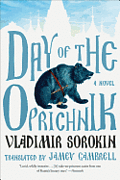Day of the Oprichnik is a futuristic Russian novel has little to do with Financial Independence but with that disclosed, let me add that I think investors need to keep a close eye on what remains the United States’ biggest nuclear rival.
This week’s issue of The Economist is a good place to start, with a cover story on Vladimir Putin: Putin’s War on the West, as well as this in-depth feature on What Russia Wants.
As we noted in an earlier Hub review of a trio of books on Putin’s Russia, when you add in the geopolitics of plunging oil prices and the perpetual skirmishes with the Chetchens and the escalating brinkmanship in the Ukraine, it might be useful for investors to keep tabs on this rogue Capitalist state.
As so often is the case, art sometimes imitates life and sometimes anticipates it. Day of the Oprichnik was published nine years ago and is looking more and more prescient. Vladimir Sorokin, born in 1955, is a prize-winning novelist based in Moscow and also wrote The Ice Trilogy. Day of the Oprichnik was published in Russia in 2006 and the first American translation was only in 2012.
Below, we also look at two more recent non-fiction books on Putin’s Russia: 2013’s Fragile Kingdom and the just-published (2015) Red Notice.
Destined for Silver Screen?
But first, back to the novel. To sum it up in a sentence, I’d say Day of the Oprichnik is a combination of A Clockwork Orange and Fahrenheit 401, Continue Reading…









